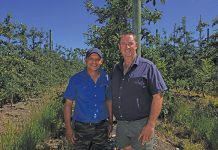Saudi Aramco World/PADIA
Aussies improve tillage under drought conditions
Directly or indirectly, most terrestrial animals depend on plants grown by fresh water, originally in the form of rainfall, for their food. All of the top five crop plants cultivated and eaten by humans – wheat, maize, rice, potatoes and soya – are freshwater-dependent and die within days of exposure to saline or sea water.
At the same time, a growing problem worldwide is to find enough fresh water and land to produce food for the world’s expanding human population. The UN’s Food and Agriculture Organisation estimates that an additional 200 million hectares will be needed over the next 30 years just to feed populations in the tropics and subtropics. Only around 93 million hectares of land is available for agriculture to expand in these regions, and much of this is forested and wild land that should be preserved. Alternative sources of water and land for crops must urgently be found.
Scientists Edward Glenn, Jed Brown and James O’Leary from the University of Arizona have done research on the feasibility of sea water agriculture – growing salt-tolerant or salt-adapted crops on land irrigated by sea water. This has especially good potential in well-drained sandy desert soils. With 97% of earth’s water found in the oceans, sea water is super-abundant. Although 43% of the earth’s total land surface is arid or semi-arid, sea water farming is only really feasible close to the sea, an estimated 15% of undeveloped land in the world’s coastal and inland salt deserts being potentially suitable. This means that sea water agriculture could produce human or animal food on around 130 million hectares of new cropland, without the need to deforest land or exploit new fresh water resources for agricultural use.
Sea water agriculture was first seriously considered after the Second World War. In 1949, ecologist Hugo Boyko and horticulturist Elisabeth Boyko used water from a brackish well and sea water to irrigate landscaping work in the Red Sea town of Eilat after the formation of the state of Israel. They found that many plants would grow beyond their normal salinity tolerances in the sandy desert soil. Their work stimulated widespread interest in extending the salinity tolerance limits of traditional agricultural crops.
Sea water agriculture has taken two directions. The first was to develop salt-tolerant varieties of conventional crops such as barley and wheat. In the late 1970s, Emmanuel Epstein of the University of California at Davis showed that some strains of barley grown for generations in low salt levels could produce small amounts of grain when irrigated by saltier sea water.
Unfortunately, efforts to increase the salt tolerance of conventional crops by selective breeding and genetic engineering produced no other suitable candidates. The upper salinity tolerance level for even the most salt-tolerant crops such as date palms is below 5 000ppm (parts per million) of salt, less than 15% of that of sea water. The salt content of sea water is normally around 35 000ppm, but along coastal deserts such as the Red Sea, the Gulf of California and the Persian Gulf, it may be closer to 40 000ppm. Sodium chloride, the most common salt in sea water, is the most harmful to plant growth.
The second approach was to domesticate wild salt-tolerant plants, the so-called halophytes, for use as food, forage and oilseed crops. The reasoning was that changing the basic physiology of a traditional crop plant from salt-sensitive to salt-tolerant would be difficult, and that domesticating suitable wild, salt-tolerant species might be more feasible. After all, all modern crops started out as wild plants. In fact some halophytes, such as grain from Palmer’s grass Distichlis palmeri, were eaten for generations by native peoples, such as the Cocopah who lived where the Colorado River empties into the Gulf of California.
To be economically justifiable, sea water agriculture must firstly produce sufficiently high yields. Second, the production system must be sustainable and must not damage the environment. Although developing appropriate agronomic procedures is a daunting task, there have been successes. One of the most notable is the commercial cultivation of samphire Salicornia bigelovi on Saudi Arabia’s northeastern desert coast, the first extensive crop of any kind ever irrigated entirely with sea water. Salicornia is used as salad greens, a tasty vegetable, for seed containing more and better edible oil than soya, as protein for animal feed and, as a by-product, straw, particle board material, and feed roughage.
This may just be one of the most important breakthroughs in agriculture since wild plants were first domesticated. – Chris Nel








